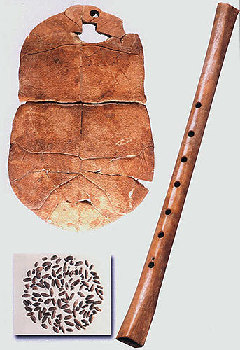Archaeological site of the Neolithic Age
Location: Wuyang County, Henan Province
Period: 7,000-5,000 BC
Excavated from 1960 to the present
Significance: It has been the earliest Neolithic cultural remains in the Huaihe River valley up to now. The site connects the Neolithic cultures of the middle reaches of the Yellow River and those of the middle and lower reaches of the Huaihe River.
 Introduction
Introduction
Jiahu is in the middle part of Henan Province, east of Fuliu Mountain and Huaihe River basin. Jiahu Site is mainly distributed over 55,000 square meters. It was discovered in the 1960s, but only in the past 15 years have significant excavation activities begun.
 |
| Tortoise shell with inscribed symbols: (left-up, length 16.2 cm); Bone bamboo flute with seven holes: musical instrument (right, length 22.7 cm); Carbonized rice: (left-bottom) |
To date, only about five percent of Jiahu has been excavated, uncovering more than 2,300 square meters, including 45 house foundations, 370 cellars, 9 pottery kilns and thousands of artifacts of bone, pottery, stone and other materials. Additional excavation activities are planned for the near future.
Recent excavations at Jiahu have yielded six complete bone flutes between 7,000 and 9,000 years old. Fragments of approximately 30 other flutes were also discovered. The flutes may be the earliest complete, playable, tightly-dated, multi-note musical instruments.
Studies of original and calibrated radiocarbon ages of the Neolithic site at Jiahu show that Jiahu's ancient rice is of 7,800-8,800 years old, that is 1,000 years earlier than that of Hemudu and Luojiaqiao. Jiahu's ancient rice is close to the rice of Pengtoushan, Lixian, in Hunan Province. Several hundred carbonized rice grains and artifacts, including Neolithic stone tools used in rice cultivation, dating 8,000 years ago, were discovered at Jiahu Site, which is an important discovery in Chinese agricultural archaeology.
